Introduction
The aims of the study were to determine how a panel of orthodontists, dentists, and laypersons rated the esthetic appeal of dentitions after orthodontic space closure by canine substitution compared with space opening and replacement of missing maxillary lateral incisors by implant-borne crowns and to compare the outcome with the results of a study in the United States in 2005.
Methods
A series of 9 posttreatment intraoral frontal photographs was presented to 87 orthodontists, 100 general dentists, and 100 laypersons. The photographs represented dentitions with either single-tooth implants or canine substitutions for missing maxillary lateral incisors and dentitions with no missing teeth. Each photograph was rated independently by assigning a number between 1 (best) and 5 (worst) for a series of 7 bipolar adjectives. Two-way analysis of variance and Tukey post hoc tests were performed to assess differences in intragroup and intergroup preferences for the various treatment options. Subsequently, the mean scores were compared with the mean scores in the study from 2005.
Results
Highly significant improvements ( P <0.0001) in the esthetic outcome for implants were found in all respondent groups when compared with the study from 2005. To date, orthodontists and dentists rank implants and canine substitution as equally pleasing, but laypersons prefer space closure.
Conclusions
Perceptions of dental esthetics can vary between dental professionals and laypersons. Investigating each patient’s esthetic expectations is thus important, but in the patient’s best interest, esthetic and functional aspects should be carefully weighed during comprehensive treatment planning.
Highlights
- •
Esthetics of implants for congenitally missing maxillary lateral incisors has improved.
- •
Laypersons prefer canine substitution.
- •
Dental professionals judge implant-borne crowns equivalent to canine substitution.
- •
Dental professionals should identify and manage patients’ expectations.
- •
Careful weighing of esthetic and functional demands during treatment planning is important.
Agenesis of one or both maxillary lateral incisors is a frequent clinical finding, which affects approximately 2% of the population. As orthodontists, we are faced with 2 treatment options: to open space for a prosthetic replacement of the missing lateral incisor mostly with an implant-borne crown or to completely close the space by mesialization of the posterior teeth with the canine substituting the missing lateral incisor. Selecting the appropriate treatment approach is a complex decision depending on the patient’s existing malocclusion, growth pattern, profile, smile line, and the size, shape, and color of the canines. It is important to consider treatment options that lead to functionally, esthetically, and periodontally acceptable results and that remain stable in the long term.
The main advantage of space closure is that the entire treatment is finished with the orthodontic treatment, and this approach allows the hard and soft tissue architecture to remain in a natural state that can better respond to the changes over time. On the other hand, the canine will need reduction in the incisogingival and mesiodistal dimensions, with flattening of the labial surface, steepening of the lingual convexity, and bleaching and composite bonding or veneering to mimic the replaced tooth. The dimensions of the premolar must be increased mesiodistally and incisogingivally, and the lingual cusp will need to be reduced.
The alternative approach consists of space opening by distalizing the canine into its natural position and preparing for prosthetic replacement, mostly dental implants, which leads to predictable and successful results, especially in patients with healthy and unrestored adjacent teeth of normal size and shape. However, placing an implant in the esthetic zone is a technique-sensitive and operator-sensitive procedure with little room for error to prevent complications, such as incomplete papillary fill, alveolar bone loss, and gingival discoloration. To achieve an optimal esthetic and functional result, it is often necessary to establish a coordinated, interdisciplinary approach involving an orthodontist, an oral surgeon or a periodontist, and a restorative dentist. The alveolar ridge will often require additional bony or soft tissue grafting to create a thick periodontal biotype that can withstand future resorptive processes and to guarantee excellent hard and soft tissue stability over time. However, it is not possible to exclude a potentially developing infraocclusion, especially in patients with poor interincisor stability.
An important aspect during treatment planning in patients with congenitally missing maxillary lateral incisors is to satisfy their esthetic demands, Nordquist and McNeill in 1975 and Robertsson and Mohlin in 2000 found that patients who had undergone orthodontic space closure with canine substitution were more pleased with the esthetic outcome than were patients treated with space opening and bridge work. In neither of those studies were single implants for replacement of the missing lateral incisors included.
In 2014, De-Marchi et al found no difference in the ratings of smile esthetics in patients with implants or space closure by dentists and laypersons when evaluating photographs of the lower facial third, but these images had the risk of distracting the respondents, especially untrained laypersons, by lip fullness or skin texture and color.
A retrospective survey of 5 patients who had been treated by orthodontic space closure vs 5 patients treated with implant-borne crowns by Jamilian et al in 2015 could not show any difference in patient satisfaction with the esthetic outcomes, but the sample size was small and not suited for any statistical analysis.
To our knowledge, the only study evaluating the esthetic appeal of implant-borne crowns and Maryland bridges vs space closure by canine substitution with intraoral frontal photographs of treated patients is a survey by Armbruster et al from 2005. Photographs of dentitions with no missing teeth served as controls. A panel of orthodontists, dentists, and laypersons judged the esthetic outcomes of the different treatment modalities. All respondent groups rated prosthodontic replacement of the missing lateral incisors as the worst.
Over the last 10 years, sophisticated surgical techniques, individual abutment designs, and new prosthodontic materials to improve the long-term stability of both pink and white esthetics of implant-borne restorations have been developed.
Therefore, the purpose of this survey was to determine (1) whether the esthetic appreciations of orthodontists, dentists, and laypersons for space closure with canine substitution, for space opening with prosthodontic replacement, and for a dentition with no missing teeth had substantially changed from 2005 to 2015; and (2) whether the implementation of the latest improvements in implantology and prosthodontics has led to an overall improvement of the esthetic outcome of implant-borne crowns for congenitally missing maxillary lateral incisors compared with the study by Armbruster et al from 2005.
Material and methods
A series of 9 intraoral frontal photographs was evaluated by a panel of 87 orthodontists, 100 general dentists, and 100 laypersons. Three clinical examples each for space closure with canine substitution for missing maxillary lateral incisors, space opening and replacement of the missing lateral incisors with implant-borne crowns, and an orthodontically treated dentition with no missing teeth in central occlusion were assessed ( Figs 1-9 ). These 9 examples had been judged as the best treatment outcomes by a panel of 4 orthodontists and 2 general dentists with more than 25 years of experience in their fields, from the authors’ (U.S., L.M.) archives for records of patients who had finished treatment at least 12 months previously. All patients had signed an informed consent form before treatment that their records might be used for scientific purposes later. The study was approved by the board of the dental faculty and the ethics committee of the University of Ferrara in Ferrara, Italy.
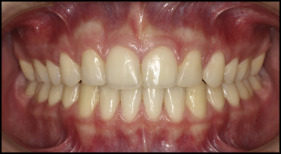
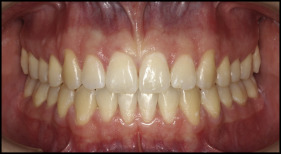
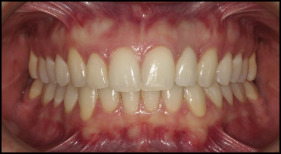
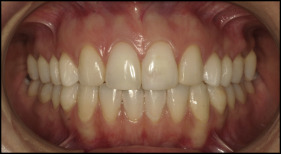
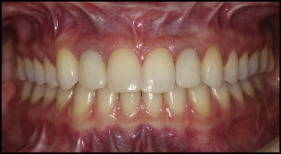
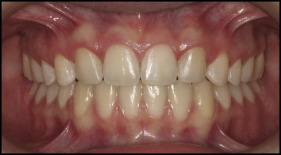
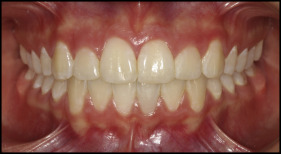

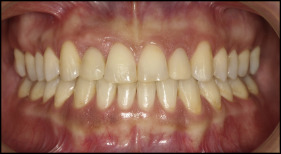
The mean age of the respondent groups was comparable, with mean ages of 37.9 years (SD ± 9.4) for orthodontists and 32.2 years (SD ± 8.1) for dentists and at least 6 years of professional experience in their fields. The laypersons (mean age, 39 years; SD ± 8.7) were patients and their relatives from the authors’ offices. Informed consent was obtained from all respondents.
No examples of Maryland bridges for prosthodontic replacement were included in this study, because preservation of the alveolar crest with a natural-looking bony contour and a perfect emergence profile are crucial for long-term stability of both pink and white esthetics but hardly achievable with any kind of bridge work.
All photographs were taken 12 to 24 months after completion of orthodontic treatment and any restorative dental work with the same digital camera with a resolution of 1280 × 960 pixels and matched in size and color using Dolphin software (version 11.7; Dolphin Imaging and Management Systems, Chatsworth, Calif).
Intraoral photographs were printed in 3.5 × 5-in format with the same ink-jet printer on premium-quality glossy photo paper, using the 1400-dpi print mode for presentation to the panel. No respondent received any additional information about the agenesis or the type of treatment provided.
To measure the esthetic appeal of the treatment results independently of one another, a questionnaire with a fixed set of 7 bipolar adjective pairs for each photograph was used, as suggested by Bishara and Jakobsen. The 7 pairs were good-bad, satisfactory-unsatisfactory, usual-unusual, nice-awful, attractive-unattractive, beautiful-ugly, and pleasant-unpleasant with a ranking from 1 (best) to 5 (worst) for each pair of adjectives. For each of the 9 photographs, the best possible score was 7, and the worst score was 35 points. Each rater was asked to circle the number that expressed his or her feeling toward the photograph most appropriately at that moment. To prevent acquiescence bias, the adjective pairs were arranged according to a random number table as described by Armbruster et al. The questionnaires were distributed and completed by dentists and orthodontists attending national dental and orthodontic meetings, with permission from the organizing committees, and by randomly selected patients and their relatives with different socioeconomic (middle to upper class) and educational backgrounds (high school and university diplomas) from the authors’ orthodontic offices. All respondents were of the same race, ethnicity, and culture.
Statistical analysis
The sum for the 3 photographs in each category (space closure with canine substitution, space opening and prosthetic replacement, and no mising teeth) was averaged, and these values were used for data analysis. Normality of the data was verified with the D’Agostino-Pearson test and equality of variance was assessed with the Levene test. Subsequently, repeated-measures analysis of variance (ANOVA) (factor for repeated measures: treatment modality) and Tukey post hoc tests were performed. All data with a P <0.05 were considered statistically significant. Data were expressed as means and standard errors. The Levene test was performed with SPSS software (version 22.0; IBM, Armonk, NY), and the other analyses were carried out with Prism (version 6.0; GraphPad Software, La Jolla, Calif).
According to Cohen, the sample size for an ANOVA with 3 groups, setting the α level at 0.05, with power of 0.8 and a medium effect size, should be 52. With a minimum of 87 respondents in each group, the analysis had at least a power of 0.8.
Results
For the intragroup rating, the esthetic scores for the various treatment options differed significantly between the 3 respondent groups.
The orthodontists ranked the dentition with no missing teeth as significantly more pleasing (12.84 ± 0.43) than both implants (15.9 ± 0.56; P <0.0001) and space closure with canine substitution (17.25 ± −0.51; P <0.001). There was no statistical difference regarding their preference for either space opening or closure.
The dentists also preferred a dentition with no missing teeth (13.35 ± −0.49; P <0.05) to either space closure with canine substitution (15.38 ± −0.59) or implant-borne crowns (15.12 ± 10.61), but with no statistically different preference between the latter.
The laypersons preferred space closure to space opening (13.97 ± −0.53 vs 16.19 ± −0.61; P <0.01). They judged space closure and canine substitution even better than a dentition with no missing teeth (14.71 ± −0.55), although this difference was statistically not significant ( Tables I and II ).
| Respondent group | Canine substitution | Implant | No missing teeth |
|---|---|---|---|
| Orthodontists (n = 87) | 17.25 ± 0.51 | 15.90 ± 0.56 | 12.84 ± 0.43 |
| Dentists (n = 100) | 15.38 ± 0.59 | 15.12 ± 0.61 | 13.35 ± 0.49 |
| Laypersons (n = 100) | 13.97 ± 0.53 | 16.19 ± 0.61 | 14.71 ± 0.55 |
| ANOVA + Tukey post hoc test | Mean difference | 95% CI of difference | Significance |
|---|---|---|---|
| Orthodontists | |||
| Canine substitution vs implant | 1.35 | 0.42 to 2.28 | ∗ |
| Canine substitution vs no missing teeth | 4.41 | 3.48 to 5.34 | ‡ |
| Implant vs no missing teeth | 3.06 | 2.13 to 3.99 | ‡ |
| Dentists | |||
| Canine substitution vs implant | 0.26 | −0.68 to 1.13 | NS |
| Canine substitution vs no missing teeth | 2.03 | 1.16 to 2.89 | ‡ |
| Implant vs no missing teeth | 1.77 | 0.9 to 3.55 | ‡ |
| Laypersons | |||
| Canine substitution vs implant | −2.22 | −3.09 to −1.35 | ‡ |
| Canine substitution vs no missing teeth | −0.74 | −1.16 to 0.12 | NS |
| Implant vs no missing teeth | 1.48 | −0.61 to 2.34 | † |
For the intergroup rating, both dentists ( P <0.05) and laypersons ( P <0.0001) preferred space closure with canine substitution to prosthodontic replacement of the missing maxillary lateral incisors compared with the orthodontists.
The orthodontists had a significant preference for a dentition with no missing teeth compared with the laypersons ( P <0.05).
No statistically significant difference between the respondent groups was found for the esthetic appeal of implant-borne crowns ( Table III ).
| ANOVA + Tukey post hoc test | Mean difference | 95% CI of difference | Significance |
|---|---|---|---|
| Canine substitution | |||
| Dentists vs laypersons | 1.41 | −0.01 to 2.83 | NS |
| Dentists vs orthodontists | −1.87 | −3.34 to −0.40 | ∗ |
| Laypersons vs orthodontists | −3.28 | −4.75 to −1.81 | † |
| Implant | |||
| Dentists vs laypersons | −1.07 | −2.49 to 0.35 | NS |
| Dentists vs orthodontists | −0.78 | −2.25 to 0.69 | NS |
| Laypersons vs orthodontists | 0.29 | −1.18 to 1.76 | NS |
| No missing teeth | |||
| Dentists vs laypersons | −1.36 | −2.78 to 0.06 | NS |
| Dentists vs orthodontists | 0.51 | −0.96 to 1.98 | NS |
| Laypersons vs orthodontists | 1.87 | 0.40 to 3.34 | ∗ |
Stay updated, free dental videos. Join our Telegram channel

VIDEdental - Online dental courses


